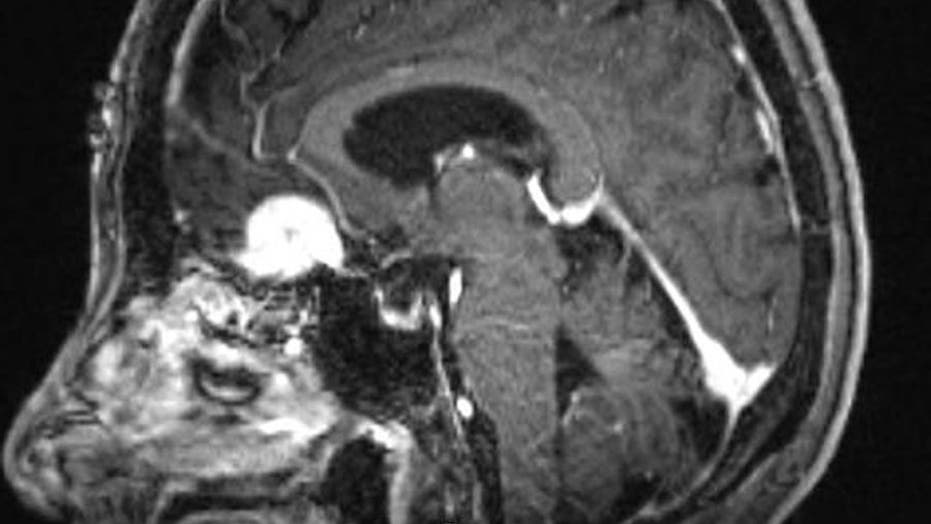Two doctors stood over a patient. One made markings next to the outer corner of the patient’s eye.
“We’re going to go in mainly through here,” he said.
The other doctor examined the markings and leaned in with a pen of his own. “Let me mark the other side just in case,” he said.
The patient eyed him warily. “I don't want to be crooked,” she said.
“We don't want you to be crooked,” the second doctor agreed.
“No,” the patient laughed. “God forbid.”
That was the conversation Sharon Byrnes, 65, had with her two doctors right before she underwent a ground-breaking procedure known as a transpalpebral orbitofrontal craniotomy on September 10 at Johns Hopkins Hospital in Baltimore, Md. To put that in layman’s terms – it’s brain surgery through the eyelid.
"Going through the eyelid offers a simpler, more direct route to the middle and front regions of the brain than traditional skull-based surgery," facial plastic and reconstructive surgeon, Dr. Kofi Boahene, who helped pioneer this procedure, said. "This minimally invasive approach also avoids the major head trauma typically associated with brain surgery."
Instead of shaving the patients head, opening the top half of the skull and moving aside whole outer sections of the brain, surgeons make a tiny incision through the eyelid creases and remove a small section of the skull bone right above the eyebrow to reach the tumor. The skull bone is later replaced.
“For this approach, the major benefit that I see to the patient is the fact that instead of going through an incision from ear to ear, now we can go right here,” Dr. Alfredo Quinones-Hinojosa, a neurosurgeon who also helped pioneer the procedure, said, pointing to his own eyelid, “and get this brain tumor out.”
The tumor, a meningioma, which occurs in the lining of the brain, was located right behind Byrnes’ eyes. It caused her brain to swell, leading to seizures and balance issues, and sometimes, she said, she just had trouble finding the right words.
But that wasn’t the worst of it. Because of the tumor, she couldn’t spend time with her grandchildren on her own.
“I can’t take them anywhere in my car,” Byrnes said. “I can’t be totally responsible for them, and that’s the thing I love doing most.”
She paused, with tears welling up in her eyes. “And that’s what hurts me the most.”
After a few hours of preoperative care, Byrnes, who is the 19th person to ever undergo this procedure, smiled and waved to the nurses as she was wheeled on a stretcher into the operating room.
This was the happy ending she had been waiting for since 2008, when her right eye became noticeably dilated. Byrnes, a resident of Hummelstown, Pa., had sought help from a local doctor, but no one had an immediate answer for her. A later MRI confirmed the presence of a tumor.
By August of the following year, Byrnes’ symptoms had worsened. She was having seizures two or three times a day. Doctors attempted to remove the tumor, but the attempt failed, and her symptoms returned, including nausea, a feeling of heavy-headedness, and balance issues.
Byrnes turned to the internet. That was how she found Quinones and an accompanying newspaper article on the procedure she would eventually undergo.
“The biggest risk is for scarring and infection,” said Boahene, who has performed more than a dozen such procedures at Johns Hopkins since 2007. “But that is very minimal. Most patients have swelling around their eyelids. We treat it with ice and usually within three days, it's back to normal.”
“In the end,” he added, “the patient is going to be left with an incision that's in the eye crease. When they open their eyes, and they're talking to you, you won't see it. And then there will be no long-lasting effects that they had this big brain surgery.”
Following the surgery, the doctors told Byrnes she could expect some discomfort, discoloration, swelling, and ultimately – a cure.
Five hours after she went into pre-ops, she was wheeled back out of the operating room and sent to intensive care. Quinones and Boahene came out to speak to her family.
“Everything went great,” Quinones said, shaking their hands. “Everything went really, really well.”
Things went so well, Byrnes was discharged from the hospital two days after the surgery. She is now recuperating at her daughter’s house.
“She hasn’t had any seizures at all and the only thing she’s taking for pain is Tylenol,” her daughter, Maria Shaffer, said. “It’s absolutely amazing – she’s doing phenomenal. She’s even playing cards with the grandkids.”
FoxNews.com's Karlie Pouliot contributed to this report.

